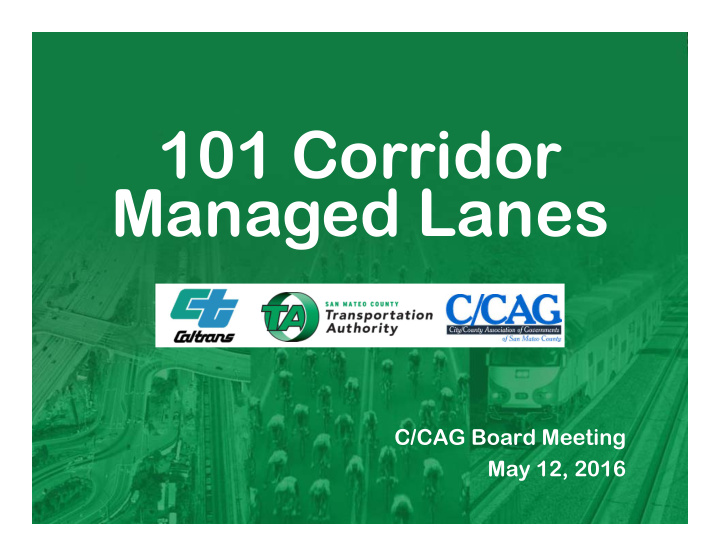



101 Corridor Managed Lanes C/CAG Board Meeting May 12, 2016
Presentation Outline • 101 Corridor Profile • System Deficiencies • Roles • Background • Managed Lanes • Proposed Purpose and Need • Alternatives Under Consideration • Schedule • Budget • Organization 2
101 Corridor Profile • 26 miles of Highway 101 in San Mateo County linking San Francisco and Santa Clara counties • 208 through-lane miles • 230,000 trips/day • Primary Access Route to: • San Francisco International Airport • Major employers • Port of Redwood City • East Bay via Dumbarton and San Mateo Bridges 3
Corridor Deficiencies • Congestion doubles travel time during the peak periods • Demand is projected to grow 10-15% by 2020 resulting in: • Increased travel time • Diversion of traffic onto local streets • Reduce transit service reliability • Increased traffic congestion-related collisions (rear-end accidents) 4
Bottleneck Queueing 5
Roles Sponsors: Implementing Agency: Lead Environmental Agency: 6
Background • May ‘15: Caltrans approved Project Study Report/Project Development Support (PSR/PDS) to extend existing High Occupancy Vehicle (HOV) lanes on 101 Corridor in San Mateo County 14.5 miles, Whipple Road to I-380. • May ‘15: TA Board authorized reallocation of savings from the PID phase to advance the start of traffic and other technical studies for the subject project. • Oct ‘15: TA Board authorized allocation of $8.5 million of Measure A funding for the Project Approval/ Environmental Document (PA/ED) phase of the project. 7
Background (continued) • Oct ‘15 - May ‘16: Received stakeholder and project team input • Project alternatives expanded to include Express Lane (EL) to allow tolling of non-HOV vehicles through congestion pricing • Project limits extended seven miles south to a total length of 22.5 miles to better coordinate with Santa Clara County • Oct ‘15: C/CAG requested the programming of state funding to supplement Measure A. The TA and C/CAG are co-sponsors. • May ‘16: Approve Supplemental PSR/PDS to document these changes; execute cooperative agreement with Caltrans 8
Managed Lane vs. General Purpose Lane GENERAL MANAGED LANE (ML) CONTROL FACTOR PURPOSE HOV HOT (GP) Hours of operation Occupancy requirements Points of access Enforcement Toll charged to non-HOV drivers O&M cost toll administration Uncontrolled operation of lane 9
Proposed Purpose & Need Purpose: Provide a continuous managed lane in each direction on 101 from the terminus of the Santa Clara County Express Lanes to I-380 to: • Reduce congestion in the corridor; • Encourage carpooling and transit use; • Provide managed lanes for travel time reliability; • Minimize operational degradation of general purpose lanes; • Increase person throughput; and • Apply technology and/or design features to help manage traffic. Need: • 101 is heavily congested resulting in an overall degradation of operations throughout the corridor. • All users, whether they are in single or multiple passenger vehicles traveling on 101, experience delays. 10
101 Corridor Managed Lanes Existing HOV Lanes Potential HOV Lane Potential Express Lane County Line 11
101 Managed Lanes Build Alterna Build A rnatives Under Considerat Under Consideration ion Sant Santa Clara County a Clara County to I-380 I-380 Convert Add a Lane General Purpose 1. HOV 2+ 1. HOV 2+ 2. HOV 3+ 2. HOV 3+ 3. HOT 2+ 3. HOT 2+ 4. HOT 3+ 4. HOT 3+ 12
Preferred Alternative Selection Criteria • Freeway Operational Improvements • Increased Person Throughput • Travel Time Reliability • Congestion Relief • Cost to Implement Alternatives • Ease and Speed of Alternative Implementation • Compatibility with Adjoining Segments 13
Anticipated Environmental Documents • CEQA: Initial Study (IS) • NEPA: Environmental Assessment (EA) • Technical Studies • Land use • Paleontology • Community Impacts • Hazardous Waste/Materials • Visual/Aesthetics • Air Quality • Cultural Resources • Noise and Vibration • Hydrology and Floodplains • Energy & Climate Change • Water Quality & Storm • Biological Environment Water Runoff • Cumulative Impact • Geology, Soil, & Seismic • Context-Sensitive Solutions 14
101 ML Environmental Schedule • 28 months to complete • Key Schedule Milestones Event Date Start Jun-16 Finalize technical studies Jan-18 Draft environmental document Apr-18 and public circulation Final environmental document Aug-18 Project Report Approval Sep-18 15
Environmental Phase Cost Estimate Task Budget Project Management $2,060,000 Traffic $1,430,000 Environmental $2,850,000 Right of Way and Mapping $230,000 Preliminary Design $4,330,000 Systems Management Interface $350,000 Public Outreach $250,000 Total $11,500,000 16
Integrated Project Delivery Team 17
Organization Integrated Project Executive Project Delivery Management Steering Team Team Committee • MEMBERS: • MEMBERS: • MEMBERS: • Caltrans • Caltrans • Caltrans • MTC • C/CAG • C/CAG • SMCTA • C/CAG • SMCTA • SMCTA • Private Sector ROLE: ROLE: ROLE: Perform necessary Coordinate technical, Through collaboration preliminary design, policy and funding and consensus-based environmental & technical aspects. Serve as an decisions, support and studies to environmentally intermediary between advise the Project clear the project Integrated Project Delivery Management Team consistent with purpose Team and Executive and other appropriate and need Steering Committee agencies / stakeholders. 18
101 Corridor Managed Lanes
Recommend
More recommend